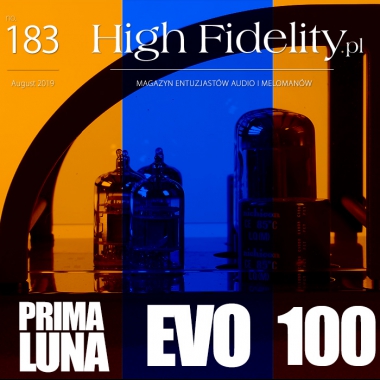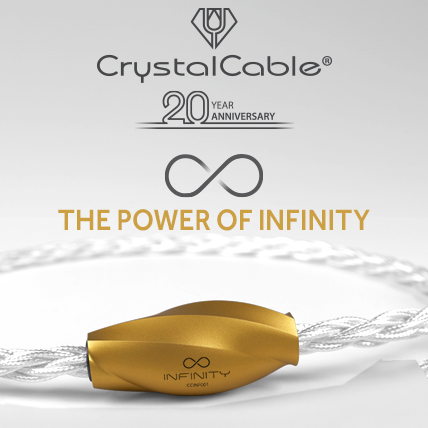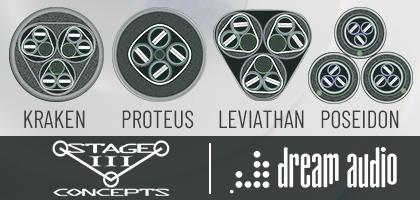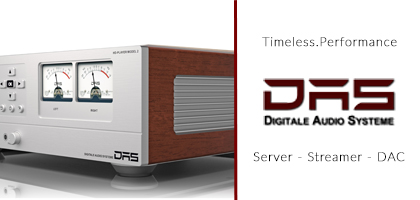No. 259 December 2025
- COVER REVIEW: LUMEN WHITE Altai ⸜ loudspeakers » AUSTRIA
- COVERAGE ⸜ audio show: HIGH FIDELITY on Audio Video Show 2025. A few worlds about time… » POLAND
- REVIEW: ACOUSTIC REVIVE Absolute Power Cord-K ⸜ power cable AC » JAPAN
- REVIEW: ANCIENT AUDIO Lektor 30th Anniversary ⸜ CD player » POLAND
- REVIEW: HAIKU-AUDIO Sol2 Pro ⸜ integrated amplifier » POLAND
- REVIEW: NORSE AUDIO X1 & X5 ⸜ power amplifier • stereo & power supply DC » SWEDEN
- REVIEW: SME Model 35 + Model Vi ⸜ turntable + tonearm » GREAT BRITAIN
- REVIEW: TiGLON MZ-Grande ⸜ anti-vibration feet » JAPAN
- REVIEW: THUNDER MELODY Ground Hub Black Edition ⸜ anti-vibration platform & ground unit » POLAND
- REVIEW: WK AUDIO TheRay Basic ⸜ analogue interconnect RCA » POLAND


|

|
|
JAPANESE POLONIKA
With this in mind, I prepared a light and pleasant reading for you in this editorial - just read it under an umbrella on the beach, on a tablet for example. I've been thinking about such an article for a long time, but there has always been something more important and more urgent - so for me writing it will be sort of a vacation. 
I would like to present to you some selected albums of Polish artists released in Japan or for the Japanese market. I do not include classical music, because I could fill up two or three editorials with albums by Robert Zimmerman, Rafał Blechacz and other Polish classical musicians. Instead, I propose that we look at releases that are less common and not so obvious - jazz and rock albums. In order to make it a fairly representative review, I reached for both LP and CD releases, originally released in Poland and abroad. I grouped them chronologically, starting with Komeda's recordings from 1960, and ending with Vader recordings of 2016:
I hope it will really be a light reading for you.  ⸠ 1960-1961 Woopie Music WOLP2502 
Released in 2001, two 10" records are a very nice curiosity. They were created as a result of cooperation between Polish companies and the Japanese publisher. It is not really known where they were pressed, but there are many indications that it happened in the Czech Republic. The publisher is Woopie Music, and the distributor was the Japanese company Norma. On the discogs.com website, in the section dedicated to the Woopie Music label, there are only seven records, and catalog numbers suggest that there could not have been more than ten titles. Release dates include only 2001 and 2002. So it looks like the company lived only for a short time. It's a pity. We have slightly more information about the distributor - one site says that it is a distribution company, other that they are a label. It probably played a double role. Let me add that Norma has also released Jancy Körössy's CD titled Jancy Körössy In Poland from 1961. 
The records contain material from 10’’ and 7’’ Polish releases - this is a "live" recording from the Jazz Jamboree festival, as indicated in the subtitle: "Jazz Jamboree 1960.1961" and "Warsaw Philharmonic - Hall Recording".

The pressing quality is very good, and so it a sophisticated graphic design. On the cover, a photo of Komeda in partial shade was used, probably by Marek Karewicz, although there is no mention of it. In the upper left corner the "Muza" logo is placed - very nice one, used by Polskie Nagrania "Muza" until 1970, but usually with a rooster and catalog number. The exception was just 10" discs, where these elements occurred separately. Sound | The sound of these recordings is appallingly good. I say this, of course, in the context of the original pressings on 7" EP and 10" LP. It sounds as if it was sourced from analogue master tapes. Probably the cutting was made of digital files, but even if that’s true, it was done really well. The sound is open, vibrant and powerful. When accumulation of sounds happens, it is presented closer to the listener, loses depth, but still has the power and the vibrancy. And when a solo instrument plays, such as a double bass, the space is beautifully opened, really natural and deep. It's a really good sounding release, the best version of those recordings I know.  ⸠ 1964 Decca SKL 4644 | Universal Classics & Jazz UCCM-9174 Format: Compact Disc, Mini LP 
Less than ten years after the Winobranie, one of the most important Polish jazz albums, in August 1964, the musician records an album in London, at Decca Studios. The sound director was Vic Smith and the producer was Michael Vernon. Vic Coppersmith-Heaven is a British sound producer. He is known for his work for the Polydor, where he recorded such classics as Matthew and Son by Cat Stevens, Let It Bleed by The Rolling Stones and With a Little Help from My Friends by Joe Cocker. In his catalog from later years, we will also find Black Sabbath and Judas Priest.
The mid-1960s are the time when the European "jazz school" was born. Music performed by Namysłowski's bands is usually referred to as a hard bop or free bop, but with a local, folk influence, audible for example in tempo changes. The Lola was recorded with his first famous quartet, formed in 1963. Maciej Lewenstien in his monograph Polish Jazz Recordings & beyond gives it only three points out of five, but I think he is a bit too harsh. 
The disc was originally released on vinyl. The release I'm talking about comes from 2003 and is part of the series "From Europe With Jazz" - Namysłowski's quartet came out as number two, and - we'll get to it right away - the third number was the NOVI Quartet’s Novi In Wonderland. We are talking about a very nice release, in the mini LP format, with an obi containing Polish flag, and inside there is a leaflet with a description of the music and information about Namysłowski himself in Japanese. 
Sound | This is a classical stereo recording for this period, with three zones - the left one with the piano, the middle with the percussion and the double bass and the right one, with the leader's saxophone. They are quite nicely connected by reverberation and by so-called "leaks," meaning the sound recorded by the microphone placed next to another instrument. It's a clean, good recording, with slightly limited dynamics and bass cut off at the very bottom. The double bass is shown slightly farther away from us, it is not too big, but maybe that was the point. The saxophone has been recorded very close, that is, the microphone was place close to the instrument, which gave it a large volume and a brought it bit closer to the listener. A light patina floats over the whole, which does not allow to show everything in a resolving way. Even so, the music is great and the sound is really good too.  ⸠ 1967 Polskie Nagrania „Muza” | EMREC EM1038LP Format: LP 12”, 33 1/3 rpm 
Bossa Novaby NOVI Singers is an album originally released in 1967 by Polskie Nagrania "Muza" as part of the "Polish Jazz" series, at number 13; The name NOVI is written in all caps because it is an acronym: New Original Vocal Instruments. It is a phenomenon of Polish jazz music, one of the best-known Polish abroad. Their albums were released in the Soviet Union, the Czech Republic, Germany and other countries. The band won the main prize of the 15th International Jazz Festival in Zürich, and in the 1970s the magazine "Down Beat" several times placed it among the three most important vocal groups.
The version I'm talking about is a special one. It was pressed in the Czech Republic, it was released by the Polish company Power Bros, but it was intended for the Japanese market - and it can sometimes be found there on the auction portals. The original cover by Marek Karewicz was used, but the characteristic, oval logo of the Polish Recordings was replaced with the EmRec logo, although the oval was still there. The label used actually comes from the mono version. 
Discogs.com service shows only three items in the EmRec "catalog" - the described album Bossa Nova, the 7"single Christin by the NOVI Vocal Quintet and a Turkish record - the latter evidently got there by mistake - in Istanbul there is a recording studio with the same name hence the confusion. |
Sound | This is a really good version of this album. Although the logo of the monophonic version appears on the label, it is a stereo recording. The new mastering, digital one by Jacek Gałwłowski, lowers the sound and sweetens it, but it is really very good. I would say that it is better than the original, maybe except for sound’s richness. The tape has being aging, however, and even the best remastering engineer is not able to restore certain elements. And the closest to the tape was the original vinyl edition. But even knowing it, having both a mono and a stereo version from 1967, one will appreciate what has been done for the version intended for Japan. Almost certainly the disc has been pressed from digital files, it lacks some saturation, but the tone, softness, "presence" - these are the elements that are here presented at a high level. Well - I liked what I heard.  ⸠ 1968 SABA SB 15 169 | Tower Records NCS-10139 Format: Compact Disc, K2HD Pro Mastering 
The presence of the second NOVI Singers album on this list should not come as a surprise - see above. The Novi In Wonderland was recorded at the SABA Tonstudio, in Villingen / Black Forest, on 22nd and 23rd February 1968. Zbigniew Namysłowski and Roman Dyląg, among others, participated in the recording. It was released by the SABA label, but it had a few more reissues later - first with the MPS Records / BASF logo, and then based on a thorough analogue remaster by the Speakers Corner Records.
The first Japanese version comes from 1998 from the "MPS Talkin 'Jazz" series, and in 2006 another reissue was released in this country, this time in the "From Europe With Jazz" series, at number 3. However, I would like to present to you the latest incarnation, version prepared by Tower Records - the largest Japanese music distributor, who also publishes their own, exclusive versions of various albums. 
Novi In Wonderland in this version was prepared form a remaster known as K2HD Pro. It seems that Japanese company was provided with digital material in hi-res files, which has been processed in Victor Entertainment studios (JVC). On pages of the victorstudio.jp one can find information that K2HD Pro is "advanced mastering process developed by FLAIR". It is based on the K2 High Definition coding system, in which information usually lost after conversion to the CD format is encoded in the material. This edition is not exclusive in any way - there is an ordinary jewelbox with an obi and a short description in Japanese inside. I have not found any information about those responsible for the remaster and release. Sound | Studio w Black Forest ma status ikonicznego – to tam nagrywano najlepsze płyty jazzowe w Niemczech, przynajmniej do czasu, kiedy firma ECM wypracowała własny styl. Dźwięk płyty Novi In Wonderland jest więc bardzo dobry. Ma uderzenie, jest rozdzielczy i dynamiczny. Ale też wokale są czasem lekko krzykliwe, jakby chciano oddać ich ekspresję, ale zapomniano o wypełnieniu. Instrumenty brzmią świetnie. Może nie tak dobrze, jak z pochodzących z rok wcześniejszych nagrań Oscara Petersona pt. Exclussively for my friends, ale to nie są szczególnie duże różnice. To po prostu bardzo dobre granie. Wokale są rozrzucone po całej scenie, często skrajnie w lewym i prawym kanale, co przeszkadza nieco w skupieniu się na nich. Co by jednak nie było, to jedna z lepszych rejestracji NOVI Singers.  ⸠ 1975/1976/1977/1978/1979 Polskie Nagrania „Muza”/Supraphon/Wifon | Belle Antique BELLE 142218-142222 Format: Compact Disc, SHM-CD, Mini LP 
SBB is one of the best known Polish rock bands in the world. Their music is usually placed next to giants of progressive rock, such as Yes, but they actually started with blues music, hence the abbreviation SBB: Silesian Blues Band. The main character in it was the multi-instrumentalist Józef Skrzek. During the fourth year of studying at the music academy he received a proposal from Tadeusz Nalepa to play with Breakout - he never returned to the academy. ⌈ Personel: Józef Skrzek – vocal, bass guitar, banjo, harmonica, keyboards, double bass, percussion instruments (from 1971)Apostolis „Lakis” Anthimos – guitar, bouzouki, drums, percussion instruments, bass guitar, keyboards (since 1971) Jerzy „Keta” Piotrowski – drums, percussion instruments (1971–1994, from 2014) ⌋ Czesław Niemen forwarded band’s carrier by inviting them to work with him on the English-language album Strange Is This World. The band played with Niemen for two years, recording two more albums: Niemen Vol. 1 and Niemen Vol. 2. In 1977, they recorded an album with Halina Frąckowiak, whose reissue with Poniatowski's remaster had just been released by GAD Records. The first SBB album, recorded live, was released in 1974. 
SBB is the only Polish band that was so painstakingly released in Japan. The specialist company, searching for unknown masterpieces of progressive music from around the world, the Belle Antique, has released four titles from the SBB catalog, and the albums have been released in the SHM-CD version. The CDs have the form of a mini LPs, with carefully cast colors, although the logos of the first publishers have been removed from the covers, which slightly weakens the effect. In thin envelopes reminding - I wonder if it was intentional - original LP covers of these albums, one finds a Japanese text describing the story of the band. The original box was also separately available for the set. Only five albums were released, without a debut one, with three discs coming from the archive of Polskie Nagrania, one from the Czech Supraphon and one which was originally released by the Wifon. 
It seems that Japanese company was provided with digital hi-res material, because Mr. Kazunori Ohara signed the digital remaster. How did this happen? - I have already written about it, so I will repeat briefly that Mr Michał Wilczyński, the head of the GAD Records, is behind this project. I asked him several times about the details but - unfortunately - he does not want to share anything about it. Sound | I have mixed feeling while listening to these discs. On the one hand, the sound is nice, smooth and clean, and on the other hand quite dull, as if the Dolby correction was used on master tapes, and when reading its content the necessary calibration was not done quite right. But that's how they recorded back then, we can’t change that. That is why dynamics is somewhat „unified” as a part of this "package". On the plus side, let me point out a well-preserved tonal balance, maybe with a slight emphasize in the upper midrange. The album recorded in Prague for Supraphon sounds a bit more open. But these are not key differences.  ⸠ 2016 Nuclear Blast Records | Ohros Records/Ward Records GQCS-90238~9 Format: 2 x Compact Disc 
The Polish death metal bands have succeeded in something that other artists have dreamed of for several decades - they are known all over the world. One of them is Vader, a group associated with thrash and death metal music. Established in 1983 in Olsztyn, it is run from the very beginning by Piotr "Peter" Paweł Wiwczarek (nota bene, a graduate of the Faculty of Biology at the Higher Pedagogical School in Olsztyn). According to the "Billboard" magazine, the since 2002 they sold around 500,000 copies of their albums worldwide.
Vader's albums have been also released in Japan. The 2016 The Empire is an eleventh studio album of this band. It was released on November 4th, 2016 by the Nuclear Blast label. The premiere of the album was preceded by a mini-album titled Iron Times from August 12th 2016 - in the Japanese version, one gets both releases in a - rarely seen anymore - double, thick box. 
Sound | Do not expect miracles - this is not an audiophile recording :) It has a cut off bottom, a withdrawn treble and extinguished dynamics. But ... what a power, what a rush it offers all the time! There are no brightenings, no flashyness, so Peter's vocals nicely fits into the whole, even if we play this album very loudly. The Japanese versions are just like that - a bit calmed down, but also richer, with a lower center of gravity, as in this case.  | WHAT”S MORE? There has been obviously much more Polish released in Japan is. Metal bands are over represented, because in addition to Vader, we can also find Behemoth albums. But during the last two years there has been a sudden explosion of popularity of Tomasz Jaskułka in this country. Released y the prestigious Nippon Columbia label, he has his devoted fans there. Other Polish musicians have a chance to benefit from his success, because in 2017, the same label also released a set titled Polish Pianism, where - apart from Mr. Tomasz - one will also find Piotr Wyleżoł, Simple Acoustic Trio, Leszek Możdżer and Michał Tokaj Trio. A year later, the continuation of this selection was released called Polish Lyricism, with works by Krzysztof Herdzin, Paweł Kaczmarczyk Audiofeeling Trio, etc. Last but not least, I would like to mention two albums that do not come from Japan, but they could easily be prepared there - both in terms of the graphics design and sound quality: The Danish Radio Jazz Group , with the subtitle Krakow Jazzklub , Poland 1966 and Jürgen Leth Quintet - concert recording from Jazz Jamboree 62 Vol. 4. 
Both albums were released by the Jazzhus Disk label as sophisticated mini LP releases, with fantastic polygraphy. This is a record company registered in 2006 in Brooklyn, USA, but led by Mr. Chih-Yu Chen, who lives in Taiwan. It aims to release rare, often forgotten jazz recordings from outside the US (more on Alex Henderson's website HERE, accessed: 11/06/2019). While Japanese releases receive so-called OBI, this label has both classic OBOI, as well as shorter but wider "overlays", contains in caps the artist, the year the recordings and the country of origin. They also prepared a 24-bit digital remaster. The album from JJ was transferred from LP, while the performance of the Danish group in an unidentified club in Krakow - from analogue tapes. In this way, without rush, we have reached the end of this editorial - I hope that you’ve had enough cooling drinks and patience to get here :) On behalf of the entire editorial staff, I wish all readers of "High Fidelity" a beautiful holiday! ■ WOJCIECH PACUŁA |
About Us |
We cooperate |
Patrons |
|
Our reviewers regularly contribute to “Enjoy the Music.com”, “Positive-Feedback.com”, “HiFiStatement.net” and “Hi-Fi Choice & Home Cinema. Edycja Polska” . "High Fidelity" is a monthly magazine dedicated to high quality sound. It has been published since May 1st, 2004. Up until October 2008, the magazine was called "High Fidelity OnLine", but since November 2008 it has been registered under the new title. "High Fidelity" is an online magazine, i.e. it is only published on the web. For the last few years it has been published both in Polish and in English. Thanks to our English section, the magazine has now a worldwide reach - statistics show that we have readers from almost every country in the world. Once a year, we prepare a printed edition of one of reviews published online. This unique, limited collector's edition is given to the visitors of the Audio Show in Warsaw, Poland, held in November of each year. For years, "High Fidelity" has been cooperating with other audio magazines, including “Enjoy the Music.com” and “Positive-Feedback.com” in the U.S. and “HiFiStatement.net” in Germany. Our reviews have also been published by “6moons.com”. You can contact any of our contributors by clicking his email address on our CONTACT page. |
 



|
   |
main page | archive | contact | kts
© 2009 HighFidelity, design by PikselStudio,
projektowanie stron www: Indecity







 utside the window it is so hot that I hardly want to live - at last I understand the problems of the main characters shown in films from the 1970s and 80s, in which the windmill rotating slowly under the ceiling brings only an illusory relief. Still, I have no idea how all these detectives, criminals and ordinary people were able to walk all day in suits and not die. At this temperature, you can’t even think, let alone act.
utside the window it is so hot that I hardly want to live - at last I understand the problems of the main characters shown in films from the 1970s and 80s, in which the windmill rotating slowly under the ceiling brings only an illusory relief. Still, I have no idea how all these detectives, criminals and ordinary people were able to walk all day in suits and not die. At this temperature, you can’t even think, let alone act.


